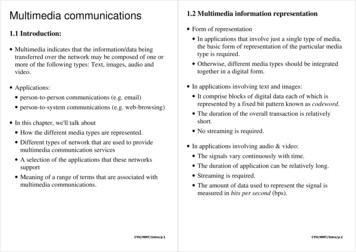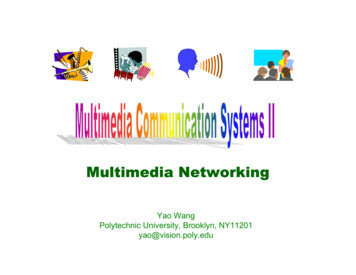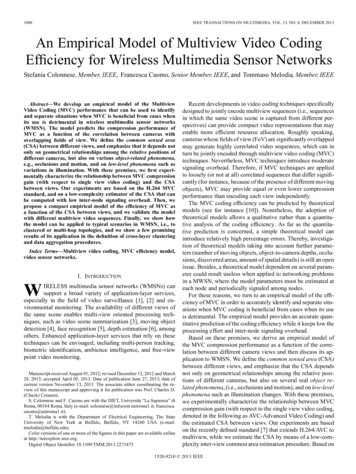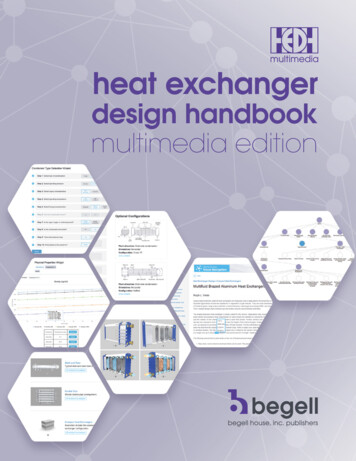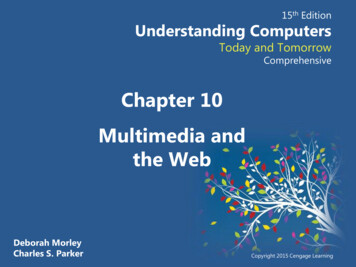
Transcription
15th EditionUnderstanding ComputersToday and TomorrowComprehensiveChapter 10Multimedia andthe WebDeborah MorleyCharles S. ParkerCopyright 2015 Cengage Learning
Learning Objectives1. Define Web-based multimedia and list some advantages anddisadvantages of using multimedia.2. Describe each of the following multimedia elements—text,images, animation, audio, and video—and tell how theydiffer.3. Briefly describe the basic steps and principles involved withdesigning a multimedia Web site.4. List the various tasks involved with developing a multimediaWeb site.Understanding Computers: Today and Tomorrow, 15th Edition22
Learning Objectives5. Explain how markup languages, scripting languages, andother tools are used today to create multimedia Web pages.6. Discuss the possible use of Web-based multimedia in thefuture.Understanding Computers: Today and Tomorrow, 15th Edition3
Overview This chapter covers:– What Web-based multimedia is and how it is used today– The advantages and disadvantages of using multimedia– Basic multimedia elements commonly found on Webpages– Steps and principles in designing a multimedia site– How a multimedia Web site is developed and the softwareused during this process– The future of Web-based multimediaUnderstanding Computers: Today and Tomorrow, 15th Edition4
What Is Web-Based Multimedia? Multimedia– The integration of a variety of media, such as text, images,video, animation, and sound Web-Based Multimedia (also called rich media)– Multimedia (sound, video, animation) located on Webpages Multimedia Sites– Are interactive– Often contain elements that users interact with directly– Display information as requested by the Web page visitorUnderstanding Computers: Today and Tomorrow, 15th Edition5
What Is Web-Based Multimedia? Fast computers and broadband Internet connections makeWeb-based multimedia much more feasible than in the past Vast majority of Web sites today include multimedia(advertisements, TV shows, podcasts, user generated content) Why Learn About Web-Based Multimedia?– Multimedia is an integral component of the Web– Businesses and individuals need to understand thecharacteristics of the various types of multimediaelements and the impact of adding them to a Web siteUnderstanding Computers: Today and Tomorrow, 15th Edition6
Web-Based Multimedia Applications Information Delivery– Photos of products, video clips and podcasts, and users’manuals are used to convey information– Important component in Web-based training (WBT) E-Commerce– Online catalogs, samples of movies and music, etc.– Virtual Reality (VR) The use of a computer to create three-dimensionalenvironments that look like they do in the real world(i.e., homes for sale) Augmented Virtual Reality - overlaying computergenerated images on top of real time imagesUnderstanding Computers: Today and Tomorrow, 15th Edition7
Web-Based Multimedia Applications Entertainment– Online TV/movies and games are available through TVnetwork sites Social Media and Virtual Worlds– Photos and videos on many social networking sites– 3D Virtual Worlds (Second Life)Understanding Computers: Today and Tomorrow, 15th Edition8
Web-Based Multimedia ApplicationsUnderstanding Computers: Today and Tomorrow, 15th Edition9
Advantages and Disadvantages ofWeb-Based Multimedia Advantages– Can deliver some content that could not be deliveredotherwise– Can address a variety of learning styles Visual learners Auditory learners Kinesthetic learners– Material more interesting and enjoyable– Many ideas are easier to convey in multimedia formatUnderstanding Computers: Today and Tomorrow, 15th Edition10
Advantages and Disadvantages ofWeb-Based Multimedia Disadvantages– Time and cost of development– The cost of hosting and delivering the multimedia needs tobe considered– The impact on visitors that have slow Internet connectionsor low bandwidth capsUnderstanding Computers: Today and Tomorrow, 15th Edition11
Inside the Industry BoxMilitary Virtual Worlds– U.S. military simulations traditionally take months to develop– Virtual world simulations can be developed much morequickly and requiresless personnel andskills– MOSES is a simulationcreated using an OpenSimgrid– Can be secured behindfirewallUnderstanding Computers: Today and Tomorrow, 15th Edition12
Multimedia Elements Text– Used to supply basic content, andto add text-based menus andhyperlinks– Serif Typeface Small lines on edges of letters More readable, used for largebodies of text– Sans Serif Typeface No lines on edges of letters Used for titles, headings, Webpage bannersUnderstanding Computers: Today and Tomorrow, 15th Edition13
Multimedia Elements– Different typefaces can convey widely different feelings– Important to select a typeface that matches the style ofthe Web site– When a consistent text appearance is required (such as fora logo) an image containing the text is used instead Images (Graphics)– Digital representations of photographs, drawings, charts,and other visual images Images are static and are available in many formats—TIF, BMP, GIF, JPEG, and PNG Clip art consists of pre-drawn images Stock photos are also available onlineUnderstanding Computers: Today and Tomorrow, 15th Edition14
Multimedia ElementsUnderstanding Computers: Today and Tomorrow, 15th Edition15
Multimedia Elements– GIF Graphic Interchange Format Commonly used for Web page images Used with logos, banners, other nonphotographicimages 256 colors max Uses lossless file compression Can be transparent Can be interlacedUnderstanding Computers: Today and Tomorrow, 15th Edition16
Multimedia ElementsUnderstanding Computers: Today and Tomorrow, 15th Edition17
Multimedia Elements– PNG Portable Network Graphics Format designed specifically for use with Web pageimages in 1996 Uses lossless compression Can compress more efficiently than GIF Can use specific color palette of 256 colors or true colorpalette of 16 million colors Can also be transparent and interlacedUnderstanding Computers: Today and Tomorrow, 15th Edition18
Multimedia Elements– JPEG Joint Photographic Experts Group Standard format for Web page photos Uses lossy file compression– Image quality is lost during compression Can use true color Can be progressive The amount of compression is specified when the file issavedUnderstanding Computers: Today and Tomorrow, 15th Edition19
Multimedia ElementsUnderstanding Computers: Today and Tomorrow, 15th Edition20
Multimedia Elements– Choosing a Graphic Format GIF or PNG—typically used for line art (clip art, logos,navigation buttons, etc.) JPEG—typically used for photographs Use thumbnail imageswhen very largeimages are requiredUnderstanding Computers: Today and Tomorrow, 15th Edition21
Multimedia Elements Animation– A series of graphical images are displayed in succession tosimulate movement– Java Applet A small program inserted into a Web page thatperforms a specific task– Animated GIF A group of GIF images saved as an animated GIF filethat is inserted in a Web page Displayed one after another to simulate movementUnderstanding Computers: Today and Tomorrow, 15th Edition22
Multimedia Elements For more complex animations, developers can useJavaScript or another scripting language– Flash, Silverlight Many Wed-based animations require a plug-in Animation and interactivity can also be achieved usingprogramming languages– Audio All types of sound including music, spoken voice, soundeffects Can be recorded using a microphone or MIDI instrument,captured from CDs, or downloaded from the InternetUnderstanding Computers: Today and Tomorrow, 15th Edition23
Multimedia Elements– Often played when an event occurs on a Web page orwhen the visitor clicks a link– Streaming audio is used to speed up delivery– Common audio file formats include: Waveform (.wav) Moving Picture Experts Group Audio Layer 3 (.mp3) Audio Interchange Format File (.aiff) Advanced Audio Coding (.aac or .m4a)Understanding Computers: Today and Tomorrow, 15th Edition24
How It Works BoxMP3 Compression– Patented compression method; MPEG Audio Layer 3– Typically compresses a CD-quality song to 1/10th of its size– Used with Internet music downloads– Uses perceptual coding and Huffman codingUnderstanding Computers: Today and Tomorrow, 15th Edition25
Multimedia Elements– Video Begins as a continuous stream of visual information,which is then broken into separate images (frames)when the video is recorded Video data, like audio data, is usually compressed Streaming video is recommended to speed up delivery Common video file formats include:.avi.mp2.mov.flv.mp4.wmvUnderstanding Computers: Today and Tomorrow, 15th Edition26
Quick Quiz1. The most common file format for Web page photographs is.a. GIFb. JPEGc. PNG2. True or False: Delivery speed is one potential disadvantage ofusing Web-based multimedia.3. A small image that is linked to a larger version of the sameimage is called a(n) .Answers:1) b; 2) True; 3) thumbnail imageUnderstanding Computers: Today and Tomorrow, 15th Edition27
Multimedia Web Site Design Web Site Design– The process of planning what a Web site will look like andhow it will function– Good planning is very important Basic Design Principles– Web pages should be interesting and exciting applications Provide information of value or interest Provide a stimulating experience– Pages should load quickly and be easy to useUnderstanding Computers: Today and Tomorrow, 15th Edition28
Multimedia Web Site Design Plan for all needed delivery methods and devices– Features that require a specific browser– Features that require little used plug-ins– The size of the page content Different devices, browsers, and screen resolutionsaffect how Web pages display– High-bandwidth items Watch image file size (use thumbnails) Use links to audio, video, and other high-bandwidthitems Use streaming audio and videoUnderstanding Computers: Today and Tomorrow, 15th Edition29
Technology and You BoxResponsive Web Design (RWD)– Focuses on building sites that are compatible with a varietyof devices– Can create multipleversions of your siteyourself or use a flexiblesite that adjusts to eachvisitor’s device– Can create a desktop siteand use a service togenerate mobile versionsUnderstanding Computers: Today and Tomorrow, 15th Edition30
Determining the Objectives andIntended Audience of the Site One of the first steps in designing a multimedia application orWeb site Objectives of the site affect its content– Main purpose– Supplemental activities and social media tie-ins Intended audience affects the appearance (such as the style,graphics, fonts, and colors) of the site Once the objectives and audience have been identified, youshould have a good idea of the main topics to be included inthe siteUnderstanding Computers: Today and Tomorrow, 15th Edition31
Using Flowcharts, Page Layouts, andStoryboards Flowchart– Used during the Web design process to illustrate how thepages in a Web site relate to one another Page Layout– Illustrates the basic layout and navigational structure of aWeb site– Typically two are created: one for the home page and onefor the rest of the pages in the site Storyboard– Ordered series of sketches showing each page or screen inan animation sequenceUnderstanding Computers: Today and Tomorrow, 15th Edition32
Using Flowcharts, Page Layouts, andStoryboardsUnderstanding Computers: Today and Tomorrow, 15th Edition33
Navigational Design Considerations Users should be able to get to most pages on the site withinthree mouse clicks– Using site maps and drop-down menus with larger Websites will help Navigational items should be placed in the same location onevery page Break long pages into multiple pages Add a text name to images A link to the home page should appear on every page Include identifying information on each page to indicatewhich page is currently displayedUnderstanding Computers: Today and Tomorrow, 15th Edition34
Navigational Design ConsiderationsUnderstanding Computers: Today and Tomorrow, 15th Edition35
Access Considerations Device Compatibility– The device being used to access a Web site affects how thesite will appear and how functional it will be– Develop a plan for mobile access of your site Assistive Technology– Hardware and software specially designed for individualswith physical disabilities Screen readers and Braille displays Alternative text (alt tags)– Also watch reading level of siteUnderstanding Computers: Today and Tomorrow, 15th Edition36
Access ConsiderationsUnderstanding Computers: Today and Tomorrow, 15th Edition37
Quick Quiz1. Which of the following is most often used to illustrate what a Webpage will look like?a. Flowchartb. Storyboardc. Page layout2. True or False: In order for a screen reading program to identify animage-based hyperlink, alternative text must be assigned to thatimage.3. A Web page that contains links to all the main pages on a Web site iscalled a(n) .Answers:1) c; 2) True; 3) site mapUnderstanding Computers: Today and Tomorrow, 15th Edition38
Multimedia Web Site Development Web Site Development– The process of creating, testing, publishing, andmaintaining a Web site Occurs after the site is designed Can be performed in-house or outsourced Creating the Multimedia Elements– Usually several different software programs are used Image editing and animation software Audio and video editing software– Each element should be saved in the appropriate size,resolution, and file formatUnderstanding Computers: Today and Tomorrow, 15th Edition39
Multimedia Web Site Development Creating the Web Site– Markup Language Uses symbols or tags to describe what a documentshould look like when it is displayed in a Web browser– JavaScript or other scripting languages can be used to adddynamic content– Web site authoring software is often used to create anentire siteUnderstanding Computers: Today and Tomorrow, 15th Edition40
Multimedia Web Site Development Hypertext Markup Language(HTML)– The original markup language– Uses HTML tags to indicatewhere effects and elementsbelong in the Web page– Some tags are paired– The computer and browserbeing used still determinesexactly how the Web page willdisplayUnderstanding Computers: Today and Tomorrow, 15th Edition41
Multimedia Web Site DevelopmentUnderstanding Computers: Today and Tomorrow, 15th Edition42
Multimedia Web Site Development Extensible Markup Language (XML)– A set of rules for exchanging data over the Web– Addresses the content but not the formatting– Uses XML tags to identify data– Allows data to be extracted and reused as needed Extensible Hypertext Markup Language (XHTML)– A newer version of HTML based on XML– Controls the appearance and format of a Web page likeHTML– Stricter rules than HTMLUnderstanding Computers: Today and Tomorrow, 15th Edition43
Multimedia Web Site Development HTML5– Newest version is designed to replace the previousversions of both HTML and XHTML– Includes new tags and features that support the creationof more complex and dynamic Web pages– Is open standard– No proprietary software or plug-ins required– New tags include video and audio for media, canvas that creates a bitmapped surface to work with,and section tags to identify the parts of a Web page( header , article , nav , etc.)Understanding Computers: Today and Tomorrow, 15th Edition44
Multimedia Web Site DevelopmentUnderstanding Computers: Today and Tomorrow, 15th Edition45
Multimedia Web Site Development Cascading Style Sheets (CSSs)– Used to specify the styles used with a Web page or anentire Web site– Specified in an Internal style sheet (head section of Webpage) or in an External style sheet Normally used in an external style sheet and connectedto web pages through a link statement in the headsection of the desired pages Styles are applied to all of the linked Web pages at onetime– Improves consistency and efficiencyUnderstanding Computers: Today and Tomorrow, 15th Edition46
Multimedia Web Site Development Wireless Markup Language (WML)– Used to create Web pages to be displayed on WAPenabled wireless devices, such some older mobile phones Scripting Languages– Used with Web pages with lots of dynamic content Allows the inclusion of scripts (instructions) in the Webpage code JavaScript, VBScript, PerlUnderstanding Computers: Today and Tomorrow, 15th Edition47
Multimedia Web Site Development AJAX– Creates faster, more efficient interactive Web applications– Only requests new data from the server, not the entire Webpage, when the page is updated– Interactive Web pages built with AJAX run faster– Normally require less bandwidth than conventional WebapplicationsUnderstanding Computers: Today and Tomorrow, 15th Edition48
Multimedia Web Site Development ActiveX– Set of specifications for reusing software components thatcan be sued to integrate multimedia and other interactiveelements into Web pages– Extends OLE (Object Linking and Embedding) to integratecontent from two or more programs– Allows a variety of types of Windows files to be viewed viaWeb pages Virtual Reality Modeling Language (VRML) and X3D– A language used to create 3D Web pages– Successor is X3DUnderstanding Computers: Today and Tomorrow, 15th Edition49
Trend BoxPush Technology and xRTML– Conventional Web pageshave the user pull data fromthe server– Push technology deliverscontent automatically as itbecomes available– One emerging option for Websites and apps for all devices isxRTML– Delivers data in a timelymanner and saves datatransfer costsUnderstanding Computers: Today and Tomorrow, 15th Edition50
Multimedia Web Site Development Web Site Authoring Software– Used to create Web pages and entire Web sites(Dreamweaver)– Appropriate JavaScript or other code is automaticallygenerated– Allows you to create an entire cohesive Web site, not justindividual pages– Allows you to easily include forms and databaseconnectivity– Often includes tests for broken links & accessibility tests– Web site builder – cloud versionsUnderstanding Computers: Today and Tomorrow, 15th Edition51
Multimedia Web Site DevelopmentUnderstanding Computers: Today and Tomorrow, 15th Edition52
Testing, Publishing, and Maintainingthe Site Web site should be thoroughly tested prior to publishing– All hyperlinks should be clicked to ensure they take theuser to the proper location– Complex animations (such as games and tutorials) shouldbe tested individually– Proofread each page or screen carefully– Use Web page code validators built into Web siteauthoring programs or online validator services– Consider a “stress test”Understanding Computers: Today and Tomorrow, 15th Edition53
Testing, Publishing, and Maintainingthe SiteUnderstanding Computers: Today and Tomorrow, 15th Edition54
Testing, Publishing, and Maintainingthe Site Once thoroughly tested, Web site is ready to be published– Identify Web server– Upload files After publishing, the Web site must be maintained– Update content and check links on a regular basis– Site should be evaluated on a regular basis to locate areasneeding improvementUnderstanding Computers: Today and Tomorrow, 15th Edition55
The Future of Web-Based Multimedia Web-based multimedia will be more exciting and moreembedded into everyday events Web-based content, cloud services, and home entertainmentdevices will likely continue to converge to allow seamlessaccess to desired content on the user’s device of choice Technology will evolve to support mobile multimedia Usage of multimedia applications that are tied to ageographical location or current status and that involve usergenerated content will also likely continue to growUnderstanding Computers: Today and Tomorrow, 15th Edition56
Quick Quiz1. Which of the following markup languages is most often used tocreate Web pages?a. HTMLb. JavaScriptc. WML2. True or False: Web site authoring software can typically be used tocreate all of the Web pages on a site, including adding animatedelements, video clips, etc.3. The HTML code would begin to bold Web page text.Answers:1) a; 2) True; 3) b Understanding Computers: Today and Tomorrow, 15th Edition57
Summary What is Web-Based Multimedia?Multimedia ElementsMultimedia Web Site DesignMultimedia Web Site DevelopmentThe Future of Web-Based MultimediaUnderstanding Computers: Today and Tomorrow, 15th Edition58
Multimedia Web Site Design Web Site Design –The process of planning what a Web site will look like and how it will function –Good planning is very important Basic Design Principles –Web pages should be interesting and exciting applications Provide informati

